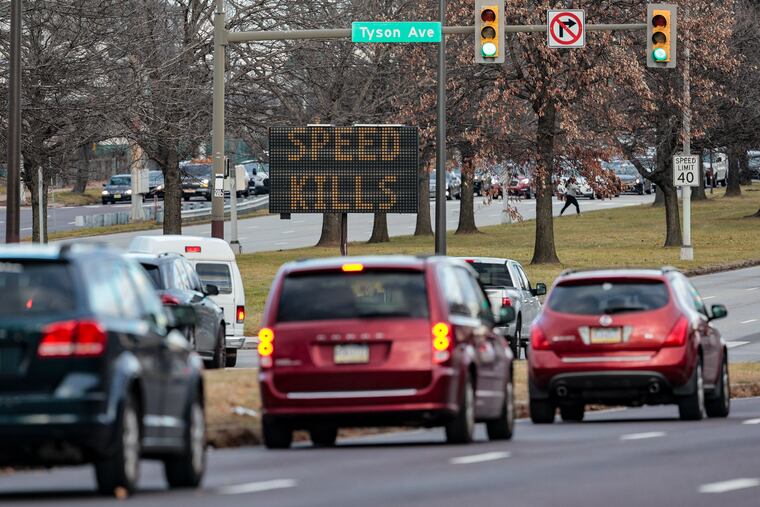Slow down and help make Philly streets safer | Editorial
Police officers are writing more traffic tickets after years of looking the other way, but the city's disinvestment in Vision Zero is a move in the wrong direction.

Years ago, the average speed of motorists along Kelly Drive reached 55 miles per hour. Despite reducing the speed limit to 25 mph recently, drivers still treat the twisting road as if they are on the Formula 1 circuit.
The reckless racing along Kelly Drive and throughout Philadelphia coincides with a steep drop in traffic citations. Over the last 25 years, the city police essentially stopped issuing traffic tickets.
During that time, the number of tickets handed out declined 91%, according to an Inquirer analysis of court data. About a half million citations were given in 1998 compared with just 45,000 last year, records show.
No surprise, the lack of enforcement has resulted in more crashes and deaths.
» READ MORE: Traffic safety measures work. Why is Philadelphia so slow in implementing them? | Editorial
On Tuesday, two motorists died in a head-on collision on North Broad Street. Hours later, a pedestrian was killed by a shuttle bus on South Front Street near Washington Avenue.
In recent months, three police officers have been injured in traffic incidents. One police officer was struck June 23 by a hit-and-run driver in North Philadelphia. Earlier this month, an officer on a police dirt bike was hit by a motorist making a U-turn in Juniata Park. In April, a person driving a red quad intentionally hit an officer traveling on a motorbike near the Walt Whitman Bridge and sped away.
Philadelphia ranks among the worst big cities to drive in. It is also one of the deadliest. Philly’s auto-related fatalities are triple the rate of New York City and double the rate of Boston, according to a 2023 city traffic study report.
Thankfully, the number of deaths has been dropping.
So far this year, 45 people have been killed in traffic collisions involving motor vehicles, 19 of them were pedestrians, according to the Philadelphia Police Department’s Statistical Unit.
The number of vehicle crashes and pedestrian deaths through the first six months of this year are down compared to the same period in recent years. There were 58 deaths during the first half of last year and 63 in 2022.
In all, Philadelphia is on pace to have the lowest traffic and pedestrian deaths since 2019. The decrease in deaths coincides with the city’s effort to force drivers to slow down.
In 2017, the Kenney administration unveiled Vision Zero, an action plan modeled after a successful effort to improve traffic safety first implemented in Sweden and adopted by other American cities.
The plan found that 50% of the traffic-related deaths and severe injuries occurred on just 12% of Philadelphia’s streets. And 53% of the traffic deaths were the result of aggressive driving, including speeding.
The implementation of red-light cameras along Roosevelt Boulevard changed drivers’ behavior and forced them to slow down along one of the city’s deadliest roads. The result has been a 36% drop in crashes.
The expected addition of speed cameras along Broad Street should help reduce speeding, running red lights and other reckless driving along one of the city’s main arteries. The same goes for the recent traffic calming measures that residents clamored for along Lincoln Drive.
Similar steps are needed in other parts of the city with high rates of collisions and deaths. But the Parker administration appears to be going the wrong way.
» READ MORE: Traffic safety, Washington Ave., and a new way of thinking about urban planning | Editorial
Despite the recent success in reducing traffic deaths, Mayor Cherelle L. Parker’s budget slashed funding for Vision Zero by 60%, from $2.5 million to $1 million. The decrease in funding comes as Philadelphia needs to do more — not less — to make the city’s streets safer for motorists and pedestrians.
Parker should not abandon good ideas just because they came from a previous administration. After all, she promised a “safer, cleaner and greener” city. Enforcing traffic laws should be part of her safety initiatives.
To be sure, police officers are writing more tickets after years of looking the other way. The department has issued 10,000 more traffic tickets this year compared to the same period last year, according to Deputy Commissioner Michael Cram.
But that remains minuscule compared to enforcement efforts years ago. The city must do more to rein in reckless motorists who believe they can drive with impunity. Setting the tone for safety starts at the top.